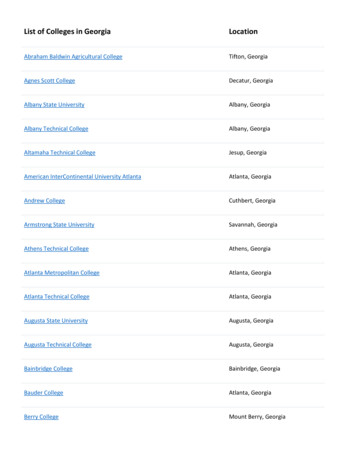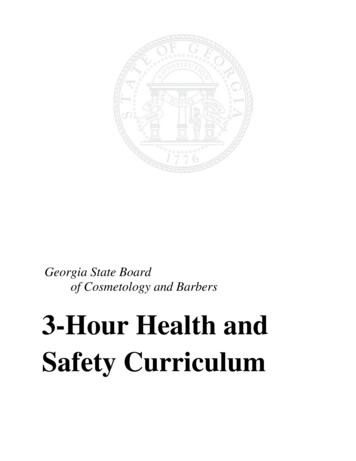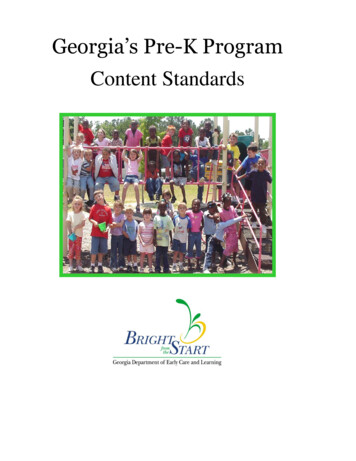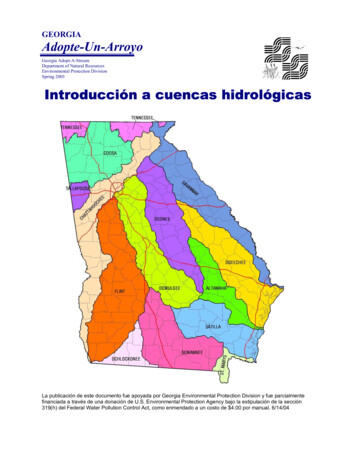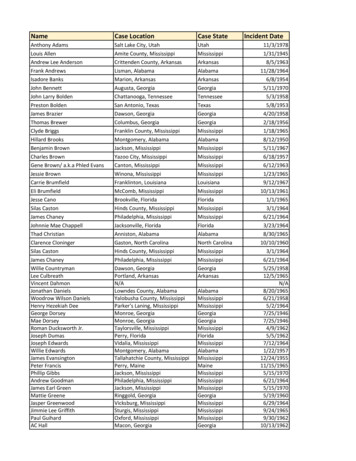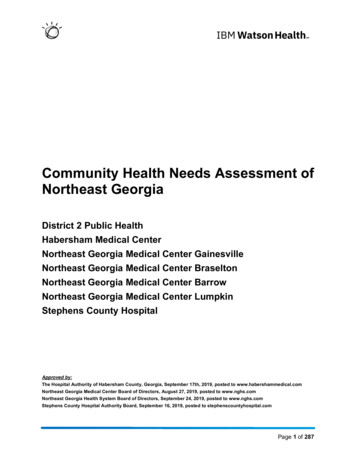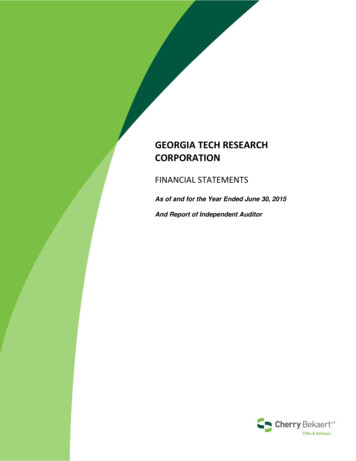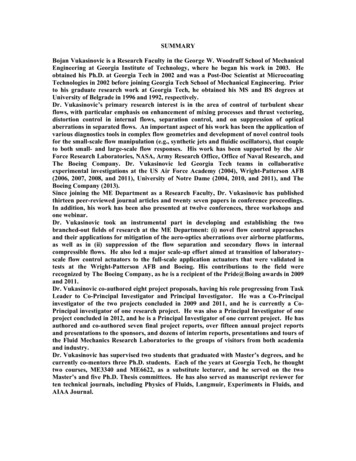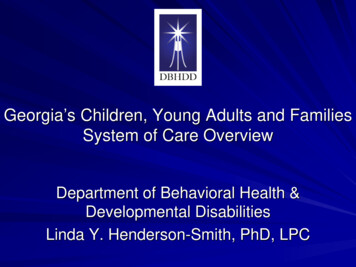
Transcription
Georgia’s Children, Young Adults and FamiliesSystem of Care OverviewDepartment of Behavioral Health &Developmental DisabilitiesLinda Y. Henderson-Smith, PhD, LPC
CFY Services & SupportsCoreSpecialtyServicesMobile sPRTFCareManagementEntity Svcs
History of System of CareSOC concept developed in the mid-80’sEvolved from the SAMHSA Child andAdolescent Service System Program(CASSP) - 1984SOC development furthered by theSAMHSA Comprehensive CommunityMental Health Services Program forChildren and Families/Children’s MentalHealth Initiative (CMHI)- 1993
History of System of CareThrough the CMHI over 170 community,tribal and state grants funded to developand implement SOC approaches toservice deliveryOver 45 System of Care ExpansionPlanning and Implementation Grants havebeen awarded since 2011 to build on theCMHI
SOC Development in GeorgiaGeorgia has focused on SOCdevelopment for 29 years parallel to SOCdevelopment throughout countryDBHDD one of ten states awardedCASSP grantDBHDD awarded a Capacity BuildingGrant
SOC Development in GeorgiaChildren’s Mental Health Initiative Grantawarded to Rockdale County, KidsNetRockdale and Walker County, WINGeorgiaChild and Adolescent State Infrastructure(CASIG) and Substance AbuseCoordination (SAC) GrantsHealthy Transitions Initiative/EmergingAdult Initiative
SOC Development in GeorgiaAlternatives to Psychiatric ResidentialTreatment Facilities Waiver DemonstrationGrant -Community Based Alternatives forYouth (CBAY) – Demonstration Waiver– Creation of CMEs as a tool for SOCCHIPRA Quality ImprovementDemonstration Grant
What is System of Care (SOC)Current Definition of SOCSOC is a spectrum of effective,community-based services and supportsfor children and youth with or at risk formental health or other challenges and theirfamilies, that is organized into acoordinated network, builds meaningfulpartnerships with families and youth, andaddresses their cultural and linguisticneeds, in order to help them to functionbetter at home, in school, in thecommunity and throughout life(Stroul and Friedman 2011)
System of CareWhat is it?A framework for how todo businessA guide for how systemsshould workAdaptive to eachcommunity, county,region and stateWhat is it not?A thing to be purchasedA fidelity model ofpractice
System of asedFamily Driven &NaturalSupportsYouth edPersistence
Family-Driven & Youth-GuidedFamily and child/youth perspectives areelicited and prioritized during all phases ofthe wraparound process.Planning is grounded in family members’perspectives.Options and choices are provided by theteam such that the plan reflects familyvalues and preferences.National Wraparound Initiative (2004).
Family-DrivenFamily-driven means families have a primary decisionmaking role in the care of their own children as well as thepolicies and procedures governing care for all children intheir community, state, tribe, territory and nation. Thisincludes:– choosing supports, services, and providers;– setting goals;– designing and implementing programs;– monitoring outcomes;– managing the funding for services, treatments andsupports and;– determining the effectiveness of all efforts to promotethe mental health and well being of children and youth.National Federation of Families
Youth-GuidedYouth Guided means that young people have the right to beempowered, educated, and given a decision making role in the careof their own lives as well as the policies and procedures governingcare for all youth in the community, state and nation.This includes giving young people a sustainable voice, being listenedto, and the focus should be towards creating a safe environmentenabling a young person to gain self sufficiency in accordance to thecultures and beliefs they abide by.Further, through the eyes of a youth guided approach we are awarethat there is a continuum of power that should be given to the youngpeople based on their understanding and maturity in this strengthbased change process. Youth guided also means that this processshould be fun and worthwhile.Youth Motivating Others through Voices of Experience (Youth M.O.V.E) 2006
Community-Based Service and support strategies that takeplace in the most inclusive, mostresponsive, most accessible, and leastrestrictive settings possible. Service and support strategies areimplemented that safely promote child andfamily integration into home andcommunity life.
Culturally CompetentAgencies, programs, and services that reflect the cultural,racial, ethnic and linguistic differences of the populationsthey serve to facilitate access to and utilization ofappropriate services and supports.Services and supports demonstrate respect for and buildson the values, preferences, beliefs, culture, and identity ofthe child/youth and family, and their community.
SOC PrinciplesThe services provided within the system of careshould be:– Comprehensive, including a broad array of servicesand supports (formal and informal)– Individualized– Provided in the least restrictive, most appropriatesetting– Coordinated at both the system and service deliverylevel– Involve families and youth as full partners, and– Emphasize early identification and intervention
Elements of a System of CarePhilosophyInfrastructureServices and Supports
Three Levels of Support for Effective SOCState System of CareSupportive OrganizationChild and Family Team
Strategies to Develop SOCImplementing Policy, Administrative,Regulatory ChangesDeveloping or Expanding Services andSupportsCreating or Improving FinancingStrategiesProviding Training, TA and CoachingGenerating SupportStroul and Friedman 2011
Interagency HILDREN& FAMILIESBehavioralHealthDPHDCHDJJ
ResourcesFor more information on System of pFor more information on High Fidelity Wraparound:www.nwi.pdx.eduFor more information or training regarding SOC, pleasecontact:Linda Y. Henderson-Smith, PhDLinda.Henderson-Smith@dbhdd.ga.gov
COE Vision and MissionVision: Children and families will haveimproved quality of life and a productivefuture as a result of systems that promoteoptimum behavioral health.Mission: To continually improve systems thatpromote optimum behavioral health byensuring a community-based approach toyouth-guided, family-driven care with a focuson shared outcomes, a competent workforce,and unbiased research.
Approach to Our Work
COE ActivitiesWorkforce Development—– Training (currently lay workforce)– Technical Assistance to provider groups includesQA/QI, using data for decision making, financing,sustainabilityEvaluation (process and outcome) &Research (most data focused on those withserious emotional disturbance)– Data Hub– Using data for decision making for QI and toimpact policy
Data collected on:Fidelity and quality improvement data for various treatmentmodalities (e.g. PRTF, CSU, CME, Clubhouse)Outcomes– Family satisfaction with care, self-reported empowerment– Health/Mental health functioning– Time spent in or recidivism to out of home placements (DJJ*,PRTF, CSU, foster care placements*)– Working to get information from DOE on schooling*Medicaid/CHIP & State FFS claims data (other limited systemdata)–––––Cost (by payer)Service utilization (movements to higher or lower levels of care)DiagnosisFoster care statusDemographics*Need data sharing agreements for data outside EBP intervention window
COE and IDTAdministrative and data backbone to IDT– AdministrativeMeeting logistics; engagement of consultantsHelps ensure sustainability of the collaborativeIDT able to maximize resources and potential for braided fundingthrough university collaboration– DataEnsures IDT has necessary data to inform decisionsData hub; helps develop data sharing agreements so collective datacan be brought back to the groupCollaborates with IDT members on data analyses and disseminationAssists in evaluation and report of annual progress of the collaborativeWork of the IDT also informs the ongoing work of theCOE and enhances their ability to accomplish their goals
The Georgia Tapestry ProjectSystem of CareExpansion Implementation GrantMelissa Robinson Graves, LMFT - Grant Director
Purpose of the CooperativeAgreementIn 2012 the Substance Abuse and Mental Health Services Administration(SAMHSA) announced a grant opportunity for the System of CareExpansion Implementation Cooperative Agreements– DBHDD funded July 1, 2013Improve the behavioral health outcomes of children and youth with serious emotionaldisturbances and their families.*Support broad-scale operation, expansion and integration of systems ofcare through the creation of sustainable infrastructure which allows for theprovision of and access to required services and supports that will allow thevalues, principles, and practices comprising the system of care approach tobecome the primary way in which children’s mental health services aredelivered throughout the nation.** From SAMHSA RFA SM-12-003
Purpose of the CooperativeAgreementTo support the availability and provision of mental health andrelated recovery support services to children with emotionaldisturbances along with the implementation of systemicchanges in policy, financing, services and supports, trainingand workforce development, and other areas that arenecessary for expanding and sustaining the system of careapproach, and to accomplish these goals through linkageswith other health reform implementation efforts.** From SAMHSA RFA SM-12-003
Population of FocusAge: Children and youth from birth to 21 years of age.Diagnosis: The child or youth must have an emotional, socioemotional, behavioral or mental disorder diagnosable underthe DSM-IV or its ICD-9-CM equivalentsDisability: The child or youth is unable to function in thefamily, school or community, or in a combination of thesesettings. Or, the level of functioning is such that the child oradolescent requires multi-agency intervention.Duration: The identified disability must have been present forat least 1-year or, on the basis of diagnosis, severity or multiagency intervention, is expected to last more than 1-year
Data Collection and PerformanceMeasurement––––Required to enter data on service and infrastructure activitiesEnter participant data into TRAC system using NOMs toolCross-site evaluation (state, local and participant/family level)Report on 12 Infrastructure, Prevention and Mental HealthPromotion (IPP) indicators quarterly:– POLICY DEVELOPMENTThe number of policy changes completed as a result of the grantThe number of agencies/organizations or communities thatdemonstrate improved readiness to change their systems inorder to implement mental health-related practices that areconsistent with the goals of the grant
IPP IndicatorsWORKFORCE DEVELOPMENT– A change made to a credentialing and licensing policy inorder to incorporate expertise needed to improve mentalhealth-related practices/activities as a result of the grantFINANCING– The amount of pooled/blended or braided funding withother organizations used for mental health-relatedpractices/activities as a result of the grantPARTNERSHIP/COLLABORATION– The number of agencies/organizations that entered intoformal written inter/intra-organizational agreements (e.g.,MOUs/ MOAs) to improve mental health-relatedpractices/activities as a result of the grant
IPP IndicatorsACCOUNTABILITY– The number and percentage of work group/advisorygroup/council members who are youth/familymembers– The number of youth/family members representingyouth/family organizations who are involved in ongoing mental health-related planning and advocacyactivities as a result of the grantAWARENESS– The number of individuals exposed to mental healthawareness messages
Goals and ObjectivesGoal 1: Implement Policy, Administrative andRegulatory Changes– Develop and refine interagency structures, agreements,and partnerships for coordination and financing at thestate, regional and local levelsDBHDD and GVRA MOU– Reduce duplication of services across agencies, limit silosand identify opportunities to enhance collaboration– Support infrastructure and service planning of localinteragency teamsLIPT members will be priority group for workforcedevelopment trainings including SOC Leadership, traumaand transition age youthRevise LIPT legislation
Goals and ObjectivesGoal 2: Developing or Expanding Services andSupports Based on the SOC Philosophy and Approach– Implement family-driven youth guided services andsupports through Family Service OrganizationsCPS-P and CPS-Y– Develop a CLC Strategic Plan to improve the CLC ofservices2013 National Culturally and Linguistically AppropriateServices (CLAS) Standards in Health and Health Care– Develop a Clubhouse Model to meet the needs of youthand young adults with co-occurring MH/SA disordersDevelop and pilot 2 MH/SA Clubhouses: CHRIS Kids &Pineland CSB
Goals and ObjectivesGoal 3: Create and Improve Financing Strategies– Develop and implement a cross–agency financial plan forservices and supports for foster care, adoption assistanceand juvenile justice youthCOE developed GA financing planGiven to SAMHSA June 30Will review and modify annually– Develop and implement a financing plan to maximize useof DBHDD resources to address service and support gapsAlso in GA financing planDBHDD will evaluate use of services and supports
Goals and ObjectivesGoal 4: Provide Training, Technical Assistance andWorkforce Development– Provide training and technical assistance on transition ageyouth toolkitDeveloped from Healthy Transitions Initiative grantimplementation– Develop CLC and SOC approach toolkits and providetraining and coachingMH/DDLGBTMilitary Families– Train child-serving agencies on trauma-informed systemsLive and e-learning training opportunitiesTraining plan developed by DBHDD and COE
Goals and ObjectivesGoal 5: Generate Support and Advocacy– Develop family and youth service organizationsChapter development and TAFederation of Families for Children’s Mental HealthYouth M.O.V.E– Cultivate Leaders/ ChampionsSystem of Care Leadership Academy– Professionals, stakeholders, advocates, familymembers, youth/young adults– Develop statewide social marketing /communicationscampaignSOC principles & values
Questions for DiscussionHow familiar is the community at large with the mental healthservices and supports available through Georgia’s System ofCare (SOC)?– What services or supports are people less aware of?What would you and/or your community like to receive moreinformation about?– What are the best ways to share this information?Are you aware of the certified peer specialists parent andyouth roles that will be added to the workforce?– What questions do you have about these professionals?– What is the best way to inform the community about these supportiveservices?– Benefits?– Challenges?
What is System of Care (SOC) Current Definition of SOC SOC is a spectrum of effective, community-based services and supports for children and youth with or at risk for mental health or other challenges and their families, that is organized into a coordinated network, builds meaningful partnerships with families and youth, and
